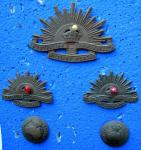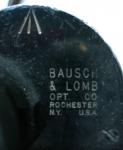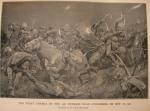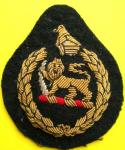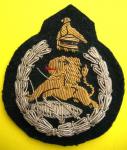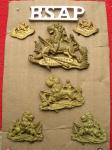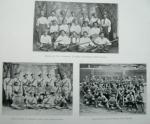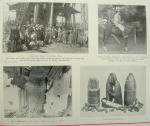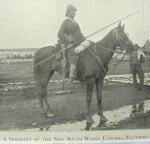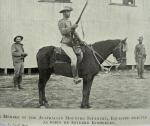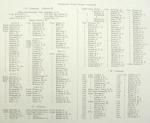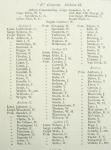-
Posts
13,225 -
Joined
-
Last visited
-
Days Won
22
Content Type
Profiles
Forums
Blogs
Gallery
Events
Store
Everything posted by Mervyn Mitton
-
Chris - one of the great difficulties our troops had was to ever get close to the Boers. They used their superior marksmanship to great advantage - they would take up a shielded position and fire on our advancing men - however, out of sight behind them, a number of their men held all of their horses and by the time our men reached the position all that was usually left was a cloud of dust. So, a night charge was an effective way of catching them un-prepared but, obviously must have been a terrible experience for everyone concerned. One of the worst incidents, where our superiority in close quarter fighting was apparent, was the 2nd battle of the War - the Battle of Elandslaagte. We were retreating fom Dundee and our 'victory' at Talana - when the Boers attacked the railway sidings at Elandslaagte , which were roughly mid-way between Dundee and Ladysmith, where we were retreating to. The Boers were caught in the open by our forces - which included a number of units. The cavalry had detachments from the 5th. Lancers; the 5th Dragoon Guards; Imperial Light Horse and - I think - Natal Mounted Rifles. They charged using both sword and lances - nine feet long (app.3metres) - the Boers made a run for it and a lot were lanced during the chase. Many Boers never forgave the British for this and it caused great enmity over the years - the famous saying they had , was - 'white men do do not do things like that to other white men' !! The reason the battles took place at Talana and Elandslaagte were for the coal. They were trying to cut us off from supplies - which in those days were vital for the railways and all our shipping. (An Eland is the largest African antelope - weighs over one ton - and laagte , means a confined area - usually surrounded with cut down thorn bushes - so, I suppose at some time it had been one to hold captured animals.)
-
The attached set of Australian badges has me a little puzzled. Apart from the left collar - which has the rounded crown, more usually associated with George 5th. - and therefore, prob. WW1 - all of the others have the sharper edged crown from late Victoria and Edward 7th. Could these be Boer War ? Any help would be appreciated. The other question - did our Aussie contingents in the Boer War wear unit badges, or, the standard half sun badge ?
-
On17th April, I posted pictures of a set of WW1 binoculars. This set is from early in WW2 and was issued to a captain in British Signals. When War commenced in 1939, despite all the talk and apparent preparations, the facts are, that we were short of every type of equipment. We had to purchase from whichever Country had required items available. This pair of field glasses are American Bausch & Lombe - a very good make. You will see that the broad arrow - to show military ownership was stamped onto the frame, and the case became standard issue webbing. What was particularly interesting, was that his issue pocket watch - also stamped with the broad arrow - was a Rolex.
-
We all like edged weapons on this sub-forum, but, perhaps we forget sometimes the 'horror' of actually having to fight with one ? This famous Illustrated London News double page is from the Boer War (1899-1902) and shows the 19th. Hussars in a night charge. They are using the standard cavalry sword of that period. These old prints are now hard to find - Lydenburg is in the Eastern Transvaal (now Gauteng)
-
That is a good point - but, wouldn't the recoil from such a heavy weapon be too much for a camel ? Do you still have access to the photo - would be interesting to see ?
-

B.S.A.P. OFFICERS' CAP BADGE
Mervyn Mitton replied to Mervyn Mitton's topic in Police Forces of the World
-
-
ROYAL WARWICKSHIRE REGIMENT - Officers' fire-gilt helmet Plate for the blue helmet. We can date it fairly accurately to between 1881 and 1901. The Cardew reforms of 1881 took numbering away from Regts. and Queen Victoria died in 1901. This would mean that this badge could have been worn in both the Egyptian Campaigns(1882-7) - and the 2nd. Boer War(1899-1902) - I think the Regt. was involved in both (?) I am hoping that this picture will lead to a new thread on this famous County regiment - I wonder if Leigh has any of those great postcards ?
-
Dear Helen - I think the lack of response, shows that you are a little out of our knowledge range with this beautiful rapier. The extreme quality and suppleness of the steel can be seen in the picture with the blade resting. Had you just shown it, I would have hazarded a guess for it to be Spanish or, Italian - there just seems to be a difference from the French. For me - at least - it will have to remain a mystery. I am hoping - when you have time - that you will show some of the truncheons - and also Zulu - from the collection ? By-the-way, did you ever establish if it was Pitt-Rivers who excavated at Dorchester ?
-
Will - I had forgotten that you had shown all your 'British South African Police ' badges under the cap. Still, we need to keep-up momentum on this new sub-forum. Are you back for a while ? Mervyn
-

BRITISH SOUTH AFRICAN POLICE CAP
Mervyn Mitton replied to Mervyn Mitton's topic in Police Forces of the World
Dear Thomas - I am so pleased that you are enjoying GMIC - I have seen your posts and thought them interesting. You've got the sword to go on yet ! Yes - I think I must have given a good laugh over PaulC's post. I never gave a thought to it being a joke - I was thinking - he must be our oldest member and having just watched - The Last Voices from World War One - DSTV on Tuesday evenings - I was feeling very generous towards 'old soldiers'. Did you see I changed my intro. to Ramblings (Lounge) , to include him on my 'hate' list. Mike - I think we all missed your mention of the TV series.Sorry ! We don't see all of these programmes in S.A. - but, it sounds pretty typical for the BBC - they always 'do' period pieces very well. I would say - if the description of the people showed a certain 'snobbish' and autocratic background - then yes ! That would be a good description - in my book - for a lot of the English that worked in East Africa some years ago. They were often what we call 'remittance' men - unwanted at home and sent to the Colonies with a monthly remittance. Kenya particularly, had numbers of them - they made the film - 'White Mischief' about their bad behaviour in the 1930's. England has nothing to be proud about some of the 'layabouts' who governed our possessions - fortunately the majority were good administrators and respected their people. In all honesty, and I have lived in most parts of the World - if I was a 'local' - I wouldn't be that keen on my past masters !! - and I include Germans, Dutch, Fench, Spanish and Portuguese in that. -

BRITISH SOUTH AFRICAN POLICE CAP
Mervyn Mitton replied to Mervyn Mitton's topic in Police Forces of the World
I take your point that it is The British South Africa Police -and it is referred to as such. I- without thinking, when I was typing - did put African , however, I am unable to change this heading now. We - who actually live-in Southern Africa - do tend to think of it as an area. Are you an ex-Rhodie - not many other people would get upset at a small typing error? Incidentally,sabrigade is a retired senior officer and doesn't deserve to be 'told off' like this. Mervyn Mitton -
Two sets of British South Africa Police badges (BSAP). Shoulder title at top - followed by Slouch Hat badge and collars , and in turn followed by , Cap badge and collars. All were gilt. They ceased to be the BSAP after 1980.
-
-
Known as 'Long Cecil' this gun was made during the Siege in the Kimberley mine works machine shop. The shell is contrasted withe the Boer 100lb. shell ( 47 kgs.) in the previous photo
-
Darrell recently posted - under GB Medals - a fine example of the Boer War QSA to the Kimberley Town Guard. I have a rare copy of the comm. volume published by the Town Council, immediately following the Siege - there are good photos, which may be of interest in this section. Most of them have the titles and this first one is the famous Mayor, who inspired the defenders and also had made the Kimberley Star.
-

QUEEN and KING SOUTH AFRICA MEDALS
Mervyn Mitton replied to a topic in Great Britain: Orders, Gallantry, Campaign Medals
There were some good pictures of the Siege - incl. uniforms - I won't spoil your post, but will put them on in the Africa sub-forum -

QUEEN and KING SOUTH AFRICA MEDALS
Mervyn Mitton replied to a topic in Great Britain: Orders, Gallantry, Campaign Medals
Dear Darrell - this is his Company - hope you can read it. I will also post the full page - but that maybe too small. The book was published immediately after the Siege, by the Town Council and lists everone involved, from all units. -
I think Australia was the same qualification as Sth. Africa - 10 years, with war service counting double. He may well have qualified before the Boer War - or, as you rightly say - was probably commissioned towards the end . Would be worth drawing papers - if they are available. Brett Hendy may be able to help - he is very good on his research. (I'm an ex-Aussie - was brought up in Melb. and Sydney.)


